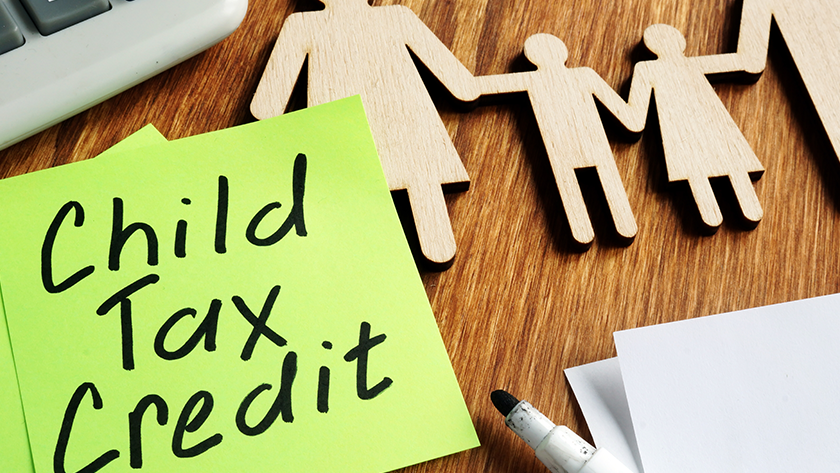
Photo Credit: VITALII VODOLAZSKYI/STOCK.ADOBE.COM
The American Rescue Plan Act expanded the 2021 Child Tax Credit (CTC) to almost 90 percent of children in the U.S. The credit is much larger and is available for the first time to the poorest families. The expansion is expected to reduce the number of children experiencing poverty by about 40 percent. It’s critical for Black and Latino children, who disproportionately missed out on the CTC previously. Families spent 2021 CTC advance payments on food and other basic needs, like housing and school expenses.
Research shows that additional income, like the expanded CTC, is associated with better outcomes for kids in families with low incomes, including stronger educational performance, improved health, and reduced stress. These positive outcomes, however, depend on families with the lowest incomes actually claiming the credit. School boards, with school administrators, educators, and social workers, can help families claim the CTC. With the ongoing COVID-19 pandemic, this assistance is critical for families and can help provide stability to students in your district.
More than 4 million children are at risk of missing out on the CTC because their parents or guardians are not required to file taxes because their incomes are below the filing threshold. Some face barriers to filing. Many families received the first half of the 2021 CTC automatically based on their past tax filings. However, families who had not filed recent tax returns faced additional steps to receive it. Some families signed up for CTC advance payments through last December and received the first half of the credit. Others did not file and are now entitled to the full credit, up to $3,000 (children 6 to 17) or $3,600 per child (under 6). Families can claim the full 2021 CTC or the remaining half by filing tax returns this year.
Schools are uniquely positioned to serve as trusted messengers. Families are most likely to claim the CTC when they hear from these messengers multiple times and are given clear referral options where they can ask questions and get tax prep assistance. Trusted messengers do not have to be tax experts to help families claim the 2021 CTC. This CTC resource toolkit from the Partnership for America’s Children and the Coalition on Human Needs makes it easy for school districts to integrate CTC outreach and tax assistance referrals into existing programs and communications. The toolkit includes the materials schools need to help families claim the credit, including flyers, sample text messages, robocall scripts, FAQs, and more.
When school districts have alerted families to the expanded CTC and how they can access free tax assistance, many families have taken action to claim the credit. The Shah Family Foundation reports that Chelsea Public Schools in Massachusetts sent 6,000 text messages to families in the district in fall 2021. The messages contained two options for families to learn more and file to claim the credit: a link to a website and the phone number for the local legal services provider. These messages resulted in 1,100 visitors to the website and over 100 phone calls to the legal services provider. The experience of Chelsea Public Schools, along with those of other districts, demonstrates the potential for schools to help families claim the CTC. When schools do so, families in your district can receive tens of thousands of dollars in CTC payments and potentially other tax credits.
In the late spring, a simplified online filing portal will open for individuals without tax filing obligations that will be easy to use and require very little documentation. The portal will help individuals determine if they are eligible to file a simplified return and whether doing so is the best option based on the different benefits for which they are eligible. For now, all families can go to www.GetYourRefund.org, where they will be directed to free in-person, virtual, or “Do-It-Yourself” tax services.
Individuals can additionally receive notifications through GetYourRefund when the simplified filing portal opens. While many families need this assistance as soon as possible and should thus file right away, it is important to note that families with no or very low incomes are not obligated to file tax returns by the April 18 tax deadline and have until late fall to do so. Schools can encourage families to file their taxes right now and reach out again when the simplified online portal is available.
School boards can take the lead in encouraging school districts to engage in CTC outreach. Providing available resources to school administrators, educators, school social workers, and others within the school community can help families claim the credit. As children and families navigate this challenging period, the CTC can provide much-needed financial breathing room.
If you have any questions, need additional resources, or want support planning CTC outreach in your school district, please contact Julia Beebe, Child Tax Credit Outreach Coordinator with the Coalition on Human Needs and Partnership for America’s Children, at jbeebe@chn.org.
Julia Beebe is Child Tax Credit Outreach Coordinator with the Coalition on Human Needs and Partnership for America’s Children.
Sources:
www.cbpp.org/research/federal-tax/build-back-betters-child-tax-credit-changes-would-protect-millions-from
www.povertycenter.columbia.edu/news-internal/2021/child-tax-credit-research-roundup
www.cbpp.org/research/federal-tax/if-congress-fails-to-act-monthly-child-tax-credit-payments-will-stop-child
www.shahfoundation.org/reports
www.irs.gov/pub/irs-pdf/p501.pdf

Share this content